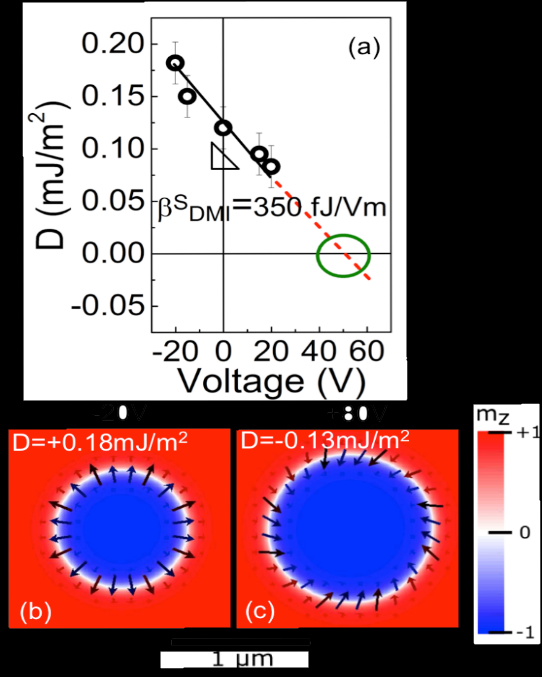The very popular magnetic bubbles called skyrmions are promising for dense data storage, logic and neuromorphic applications thanks to the unique sense of rotation (chirality) of their surrounding domain wall.
The so-called Dzyaloshinskii−Moriya Interaction (DMI) is crucial for their stability.
Here, T. Srivastava et al. have shown that DMI can be dynamically and locally controlled with a gate voltage, thus paving the way towards a control of the skyrmion chirality.
The topology of skyrmions, these circular magnetic domains encircled with a single chirality domain wall, allows them to be shifted undistorted under an electric current with great efficiency.
This behaviour makes them very attractive for spintronic applications where they could be used as nanoscale data bits for data storage, logic or more recent neuromorphic devices.
The Dzyaloshinskii−Moriya Interaction (DMI) determines the chirality of the skyrmion domain wall. In ultrathin trilayers composed of a heavy metal (HM), a ferromagnet (FM) and an oxide, DMI has an interfacial origin related to the asymmetry of the structure.
The application of a gate voltage on the structure induces an electric field at the interface, hence modifying the DMI amplitude because of spin-orbit effect.
T. Srivastava et al. have shown the first demonstration of a large (130%) tuning of DMI with electric field (see Fig(a)).
This study, published in Nanoletters, was performed in Ta/FeCoB/TaOx trilayers and results from the collaboration of teams from Spintec and Institut Néel in Grenoble and the Laboratoire des Sciences des Procédés et des Matériaux in Villetaneuse.
To directly access DMI variation under a gate voltage, they have used Brillouin Light Spectroscopy (BLS) through a transparent gate. By combining BLS and polar magneto-optical Kerr-effect microscopy, they further show a monotonic variation of DMI and skyrmion size with electric field with an unprecedented efficiency.
(a) Evolution of DMI coefficient D under a gate voltage (black circles represent data points).
Extrapolation (dashed line) to higher voltages is expected to lead to DMI sign reversal. (b) and (c) Micromagnetic simulations using experimental magnetic parameters (-20V) and extrapolated ones (+80V) leading to opposite chirality skyrmions.
From the extrapolation of experimental data to higher voltages, they expect a sign reversal of DMI with electric field (see Fig (a)).
The micromagnetic simulations performed for this study show that a change of sign would lead to a chirality switch (see Fig(b & c)). This local, dynamic and reversible manipulation of DMI establishes an additional degree of control to engineer programmable skyrmion-based memory or logic devices.
Team(s): Sensors, Spin-orbitronics
Collaboration: Institut Néel, Laboratoire des Sciences des Procédés et des Matériaux,
Funding: French ANR (contract no. ELECSPIN ANR-16-CE24-0018), University Grenoble Alpes (project Automag2D), Nanosciences Foundation.
Further reading: Large-Voltage Tuning of Dzyaloshinskii−Moriya Interactions: A Route toward Dynamic Control of Skyrmion Chirality, T. Srivastava, M. Schott, R. Juge, V. Křižáková, M. Belmeguenai, Y. Roussigné, A. Bernand-Mantel, L. Ranno, S. Pizzini, S.M. Chérif, A. Stashkevich, S. Auffret, O. Boulle, G. Gaudin, M. Chshiev, C. Baraduc, and H. Béa, Nanolett. 18, 4871 (2018). DOI: 10.1021/acs.nanolett.8b01502
Contact : helene.bea@cea.fr; claire.baraduc@cea.fr





